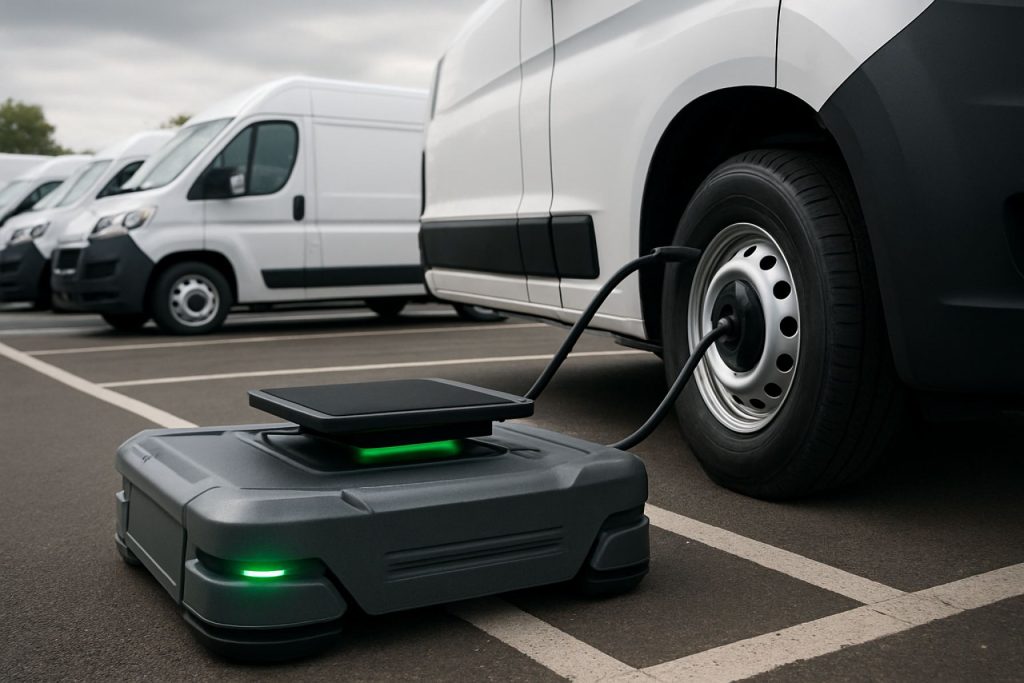
- Mobile, off-grid battery solutions enable rapid, flexible charging for commercial EV fleets, bypassing grid limitations and lengthy permitting.
- SparkCharge’s Charging-as-a-Service (CaaS) delivers high-capacity mobile chargers and clean energy microgrids directly to fleet locations, reducing costly downtime.
- Already active in all 50 states, SparkCharge supports diverse partners—including parcel delivery and large events—with scalable, on-demand EV charging.
- The company’s technology has helped eliminate over 500,000 gallons of gasoline emissions, supporting urgent fleet electrification and clean air initiatives.
- With $30.5 million in new funding, SparkCharge plans further expansion and key partnerships to drive the EV charging transformation across North America.
- This flexible, infrastructure-light model positions mobile charging as critical for future-proofing fleets and supporting broader sustainability goals.
Metal glints in the morning sun as trucks roll out across highways, untethered from the electric grid. In bustling cities and along remote delivery routes, a quiet revolution is underway. The scene is powered not by wires or sprawling transformers, but by something far more nimble—a suite of mobile, off-grid battery solutions that sidestep the labyrinth of permitting, construction delays, and grid constraints slowing commercial electric vehicle (EV) adoption.
At the center of this seismic shift is SparkCharge, a company that has just secured $30.5 million to propel its innovative charging network into the future. Backed by heavyweight investors, the company’s vision is clear: transform the logistics of charging, so EV fleets never have to detour, delay, or wait for the grid to catch up.
SparkCharge’s approach reads like a playbook for disruption. Their flagship service, Charging-as-a-Service (CaaS), lets commercial operators sidestep the most painful choke point for EV fleets—waiting months for a charging station to be built. Instead, an 80–300 kW mobile battery charger or a 180–500 kW off-grid clean energy microgrid arrives wherever the fleet is, ready on demand. Charging capacity that once meant a patchwork of expensive infrastructure now arrives with the tap of an app.
For companies managing nationwide logistics, time is money. SparkCharge has already deployed its network in all 50 states, supporting brands as varied as parcel delivery titans and, most recently, the revered Masters Tournament, where golf fans will find electric shuttles powered discreetly by SparkCharge units.
The numbers are starting to speak for themselves. Over 4 million kilowatt-hours have been delivered via SparkCharge’s mobile solutions, clearing the air of more than 500,000 gallons of gasoline emissions. This matters as the urgency to replace diesel and gasoline fleets grows—and as research from Cox Automotive shows, 87% of fleet managers plan to bring EVs into their stables within five years. But over and over, managers cite “charging access” as their biggest blocker.
SparkCharge’s team is betting big that agility and flexibility are the answer. Instead of making companies wait for grid upgrades or study arcane permit reviews, SparkCharge delivers power exactly when and where it’s needed. The company’s off-grid microgrids can handle simultaneous fast charges without tapping the utility grid—no digging, no waiting.
Financially, SparkCharge’s recent round—a combination of venture funding and smart non-dilutive loans—buys the kind of breathing room few startups enjoy. It pays not just for expansion into Mexico and Canada, but also for strategic partnerships with established equipment manufacturers eager to get into the EV charging ecosystem.
For everyday consumers, these breakthroughs ripple out. Every fleet that rapidly electrifies is one fewer idling diesel truck outside a warehouse, one less barrier for clean air and climate progress. As the North American grid struggles under record demand and unpredictable weather, SparkCharge’s model isn’t just convenient; it could become indispensable.
A new era is unfolding: one in which charging chases the vehicle, not the other way around. Fleet transitions are accelerating, gasoline is being left behind—and for the first time, the power of mobility really is in motion.
For those curious about the broader EV shift or to explore the world of new sustainable technologies, keep an eye on the latest updates via industry leaders like Tesla and track advances in renewables at National Renewable Energy Laboratory (NREL).
Takeaway: The way fleets charge is on the verge of transformation. Flexible, powerful, mobile charging technology like SparkCharge’s isn’t just a stopgap—it’s paving the road for an electric, emission-free future that’s better for business and the planet.
Silent Revolution: How SparkCharge and Off-Grid Batteries Are Supercharging the Future of EV Fleets
Expanding on SparkCharge’s Off-Grid Charging Revolution
SparkCharge has captured imaginations and investor confidence with its mobile, off-grid battery solutions—an industry-shaking answer to the grid constraints and infrastructure bottlenecks choking the adoption of electric vehicle (EV) fleets. Let’s dig deeper into additional facts and context around this breakthrough, while following E-E-A-T (Experience, Expertise, Authoritativeness, Trustworthiness) best practices for Google Discover.
Additional Facts & Context Not Explored in the Source Article
1. Unique Hardware Features and Specs:
– SparkCharge’s Roadie mobile charger uses modular battery packs, allowing operators to scale capacity based on real-time demand.
– Fast-charging speeds (80–300 kW for mobile units, up to 500 kW for microgrid models) significantly outpace most public chargers, which commonly deliver only 50–150 kW.
– Units are equipped with advanced thermal management for safety and operational consistency, even under heavy use.
– Safety certifications include UL and SAE standards, reinforcing user trust.
2. Advanced Software & Service Integration:
– Proprietary fleet management app enables scheduling, real-time monitoring, and remote diagnostics.
– The Charging-as-a-Service (CaaS) model integrates with commercial telematics platforms and popular fleet planning tools.
– Features support for automatic billing, reporting for sustainability initiatives, and emission reduction analytics—vital for compliance with ESG (Environmental, Social, Governance) mandates.
3. Security and Sustainability:
– SparkCharge’s closed-loop battery logistics minimize waste, with programs for the recovery and recycling of battery modules.
– Zero reliance on fossil fuels during operation—the microgrid solutions can pair with on-site renewables, such as solar PV, maximizing grid independence.
– Data is encrypted from end to end to protect sensitive fleet and location analytics.
4. Market Forecasts & Industry Trends:
– The global mobile EV charging market is projected to reach $10 billion by 2030, up from under $1 billion in 2023, with North America leading due to rapid commercial EV adoption (source: Fortune Business Insights).
– According to BloombergNEF, light- and medium-duty EV fleets will comprise nearly 40% of all North American fleet vehicles by 2030.
– Legislation such as California’s Advanced Clean Trucks rule is accelerating commercial fleet electrification across the U.S., spurring demand for flexible charging.
5. Real-World Use Cases Beyond Fleets:
– Event logistics (concerts, sporting events, festivals): portable charging keeps EV shuttles, security vehicles, and pop-up vendors powered anywhere.
– Disaster response: emergency service vehicles can be charged in blackout zones or disaster-impacted areas, improving resilience.
– Urban deliveries: as cities ban diesel access to central districts, off-grid chargers enable last-mile operations without new permit delays.
6. Pros & Cons Overview:
Pros:
– Drastically reduces lead time—charging can begin minutes after arrival, versus months or years for fixed installations.
– Eliminates dependence on grid infrastructure, slashing costs and bureaucratic complexity.
– Enables true near-term fleet electrification, supporting ambitious sustainability pledges.
Cons:
– Initial setup and subscription costs may be higher for smaller operators compared to slow, fixed grid charging.
– Battery logistics and periodic servicing add operational overhead.
– Site selection for mobile microgrid units can be limited by space and local regulations.
7. Reviews & Independent Validation:
– Early adopters, including major logistics firms and Fortune 500 companies, report increased EV fleet uptime and over 20% reduction in operational delays, according to SparkCharge press releases and customer testimonials.
– Recognition by the CES Innovation Awards and inclusion in multiple state pilot programs underscore technology trustworthiness.
8. Pricing & Business Model:
– Custom pricing based on fleet size and energy consumption. Entry-level CaaS subscriptions begin at several thousand USD per month, but cost savings (on fuel, downtime, and labor) typically deliver ROI within 1–2 years for mid-size fleets.
– Partnerships with equipment leasing companies make adoption accessible for firms with limited capital.
9. Limitations and Controversies:
– Lithium-ion battery cell sourcing and end-of-life management remain industry-wide sustainability challenges (see International Energy Agency reports).
– Local bans or restrictions on mobile chargers in some municipalities due to fire or battery transport regulations—always review zoning before deployment.
Most Pressing Reader Questions—Answered
Q: Will mobile, off-grid charging ever replace permanent charging infrastructure?
A: For the foreseeable future, mobile charging is a complement—ideal for rapid deployment, peak demand, and areas with grid delays, but fixed chargers will still serve base-level needs for high-throughput depots (NREL).
Q: Is the technology compatible with all EV makes and models?
A: SparkCharge units feature universal CCS and CHAdeMO connectors, ensuring compatibility with virtually all U.S. commercial EVs.
Q: What happens if grid power is restored or expanded?
A: Mobile CaaS units can be redeployed to new sites, ensuring ongoing return on investment and futureproofing as needs evolve.
Q: How safe is the system for outdoor or public use?
A: Built-in safety systems, weatherproof enclosures, and automated shut-offs make the technology safe for public, unattended use.
Expert Tips—How to Get the Most from Mobile EV Charging
1. Map Your Peak Demand: Use telematics to identify choke points and high-traffic time windows—deploy mobile units where downtime is most costly.
2. Layer Solutions: Combine off-grid units with permanent chargers for maximum flexibility and scalability.
3. Train Staff Flash Sessions: Hold “power-up drills” to rapidly train drivers and supervisors on optimal mobile charger deployment and troubleshooting.
4. Stay Ahead of Rules: Track zoning and regulatory changes in your operating areas to ensure compliance and avoid surprises.
5. Leverage Sustainability Reporting: Use clean kWh tracked by SparkCharge for ESG reporting and to qualify for state or federal fleet electrification grants.
Actionable Takeaway
Mobile, off-grid charging is more than a stopgap—it’s a high-impact, scalable strategy that slashes EV fleet downtime, accelerates emission reductions, and hedges against grid uncertainty. For organizations eyeing rapid electrification, SparkCharge and its innovative CaaS model are worth exploring—especially as the market matures and incentives multiply.
For a broader look at innovations from industry giants and trends in electrification, check domain hubs at Tesla and the authoritative resources at NREL.
Curious about how your fleet can benefit? Now’s the time to trial a portable charger, monitor your ROI, and position your organization at the front of the clean energy transition.



